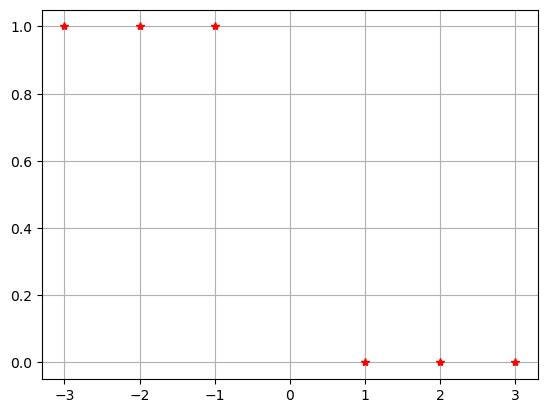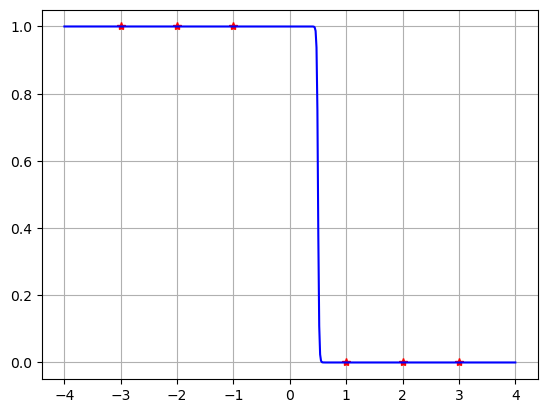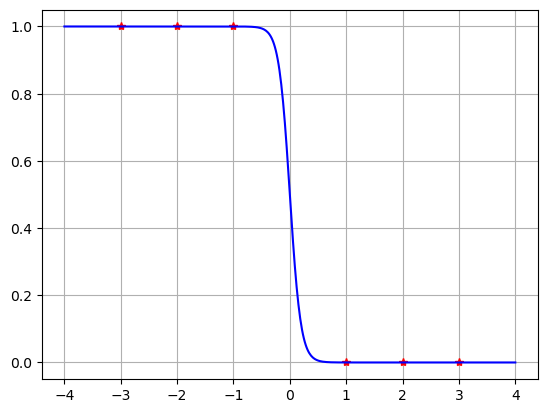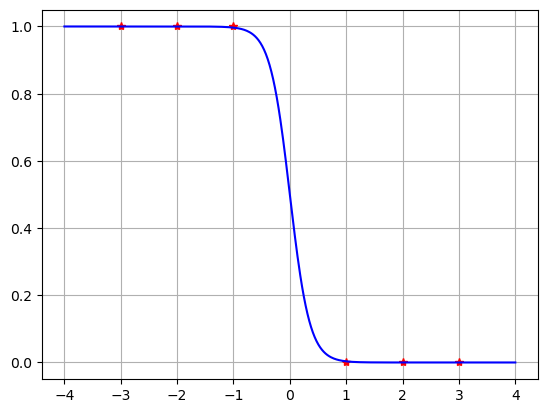Cost and Regularization#
import numpy as np
import matplotlib.pyplot as plt
import scipy.optimize as spo
Logistic Regression#
Suppose we have \(N\) data points \((x_0,y_0),\dots,(x_{N-1},y_{N-1})\) such that the targets are binary: \(y_k = 0\) or \(y_k = 1\) for \(k=0,\dots,N-1\). The goal of logistic regression is to find parameters \(W\) and \(b\) such that \(\sigma(x;W,b)\) “best fits” the data. Experiment with different values \(W\) and \(b\) to find a best fit line for the data below.
x = np.array([-3,-2,-1,0,0,1,1,2,3])
y = np.array([0,0,0,0,1,0,1,1,1])
W = 1.2
b = -0.6
sigma = lambda x: 1/(1 + np.exp(-(W*x + b)))
X = np.linspace(-4,4,100)
Y = sigma(X)
plt.figure(figsize=(8,2))
plt.plot(x,y,'r*',X,Y,'b'), plt.grid(True)
plt.show()

See also
Check out Wikipedia: Logistic Regression for more information.
Least Squares Cost Function#
We need to define a cost function to find a line of “best fit”. We say that a model \(\sigma(x;W,b)\) best fits the data if the parameters minimize the cost function.
The mean least squares cost function is
Write a Python function called costLS which takes parameters W, b, x and y, and returns \(C_{LS}(W,b; x,y)\).
sigma = lambda x,W,b: 1/(1 + np.exp(-(W*x + b)))
costLS = lambda W,b,x,y: 1/len(x)*np.sum((y - sigma(x,W,b))**2)
Use the function to compute the cost for the data in the previous example with \(W=1.2\) and \(b=-1\). Try to modify the parameters \(W\) and \(b\) to minimize the cost.
x = np.array([-3,-2,-1,0,0,1,1,2,3])
y = np.array([0,0,0,0,1,0,1,1,1])
costLS(1.2,-1,x,y)
0.12963850207631072
Cross Entropy Cost Function#
The cross entropy cost function:
Write a Python function called costCE which takes parameters W, b, x and y, and returns \(C_{CE}(W,b; x,y)\).
sigma = lambda x,W,b: 1/(1 + np.exp(-(W*x + b)))
costCE = lambda W,b,x,y: -1/len(y)*np.sum(y*np.log(sigma(x,W,b)) + (1 - y)*np.log(1 - sigma(x,W,b)))
Use the function to compute the cost for the data in the previous example with \(W=3\) and \(b=-1\). Try to modify the parameters \(W\) and \(b\) to minimize the cost.
x = np.array([-3,-2,-1,0,0,1,1,2,3])
y = np.array([0,0,0,0,1,0,1,1,1])
costCE(3,-1,x,y)
0.4340596605839115
Regularization#
Consider the following example:
x = np.array([-3,-2,-1,1,2,3])
y = np.array([1,1,1,0,0,0])
plt.plot(x,y,'r*'), plt.grid(True)
plt.show()

Because the data is separated, we can take the limit \(W \to \infty\) with \(b=0\) to get the step function which perfectly matches the data. However there is not a unique solution since we could allow any \(b\) such that \(-W < b < W\). And also we don’t want to consider infinite limits when doing mathematical computing.
W = -100
b = 50
costLS(W,b,x,y)
6.200126626701395e-45
X = np.linspace(-4,4,500)
Y = sigma(X,W,b)
plt.plot(x,y,'r*',X,Y,'b'), plt.grid(True)
plt.show()

Regularization adds a penalty for large values of the weight parameter \(W\). There are different ways to regularize such as \(L^2\) regularization, \(\alpha |W|^2\), and \(L^1\) regularization, \(\alpha |W|\), where \(\alpha\) is the regularization parameter.
Write a Python function called costCEL2 which takes parameters W, b, x, y and alpha, and returns the cross entropy cost function with \(L^2\) regularization:
costCEL2 = lambda W,b,x,y,alpha: -1/len(y)*np.sum(y*np.log(sigma(x,W,b)) + (1 - y)*np.log(1 - sigma(x,W,b))) + alpha*np.abs(W)**2
Use the function to compute the cost for the data in the previous example with \(W=-10\) and \(b=0\) and \(\alpha = 10^{-6}\). Try to modify the parameters \(W\) and \(b\) to minimize the cost.
x = np.array([-3,-2,-1,1,2,3])
y = np.array([1,1,1,0,0,0])
W = -10.3
b = 0
costCEL2(W,b,x,y,1e-6)
0.00011730122027635695
X = np.linspace(-4,4,500)
Y = sigma(X,W,b)
plt.plot(x,y,'r*',X,Y,'b'), plt.grid(True)
plt.show()

Computing Parameters with SciPy#
Next time we will develop the gradient descent method to compute optimal parameters for logistic regression. Today let’s just use the function scipy.optimize.minimize takes a function \(F(\mathbf{z}) : \mathbb{R}^n \rightarrow \mathbb{R}\) and initial value \(\mathbf{z}_0\) can approximates a point \(\mathbf{c} \in \mathbb{R}^n\) such that \(F(\mathbf{c})\) is minimum.
In our case of fitting a logistic function to data using the cross entropy cost function with \(L^2\) regularization, we input the function
where \(\mathbf{z} = [W,b]\). Use scipy.optimize.minimize to compute the optimal parameters for the example above.
F = lambda z: z[0]**2 + z[1]**2
result = spo.minimize(F,[1,1])
result
message: Optimization terminated successfully.
success: True
status: 0
fun: 2.311471135620994e-16
x: [-1.075e-08 -1.075e-08]
nit: 2
jac: [-6.600e-09 -6.600e-09]
hess_inv: [[ 7.500e-01 -2.500e-01]
[-2.500e-01 7.500e-01]]
nfev: 9
njev: 3
alpha = 0.1
F = lambda z: costCEL2(z[0],z[1],x,y,alpha)
spo.minimize(F,[1,1])
message: Optimization terminated successfully.
success: True
status: 0
fun: 0.2626698735210554
x: [-1.031e+00 -2.064e-05]
nit: 9
jac: [ 1.006e-07 -2.306e-06]
hess_inv: [[ 1.910e+00 -2.590e-03]
[-2.590e-03 8.234e+00]]
nfev: 30
njev: 10
x = np.array([-3,-2,-1,1,2,3])
y = np.array([1,1,1,0,0,0])
plt.plot(x,y,'r*'), plt.grid(True)
plt.show()

x = np.array([-3,-2,-1,1,2,3])
y = np.array([1,1,1,0,0,0])
alpha = 1e-4
F = lambda z: costCEL2(z[0],z[1],x,y,alpha)
result = spo.minimize(F,[1,1])
W = result.x[0]
b = result.x[1]
print("W =",W,"b =",b)
W = -5.680855932996707 b = -0.00016131134810909442
X = np.linspace(-4,4,500)
Y = sigma(X,W,b)
plt.plot(x,y,'r*',X,Y,'b'), plt.grid(True)
plt.show()

